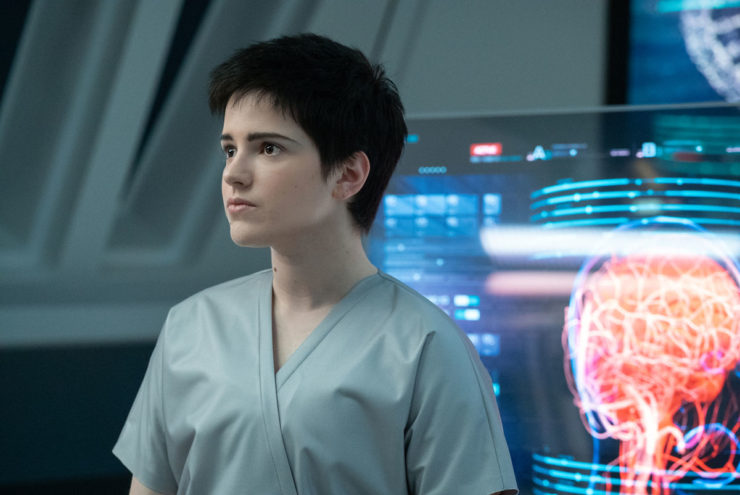There’s a particular personality quirk to pilots that Star Trek hasn’t really done much with, despite having pilots in the main cast of most of their shows. It’s been better portrayed in other genre shows—notably, the Stargate franchise in O’Neill, Sheppard, and Mitchell—and we’ve had moments of it, particularly in TNG’s “Chain of Command, Part II” and occasionally on Voyager with Paris and Chakotay.
This week on Discovery, we get to see Detmer in her full pilot-y glory.
In the “previously on Star Trek: Discovery” segment of this week’s episode, they made sure to show how badly Detmer was handling the aftermath of Discovery’s crash landing. I was hoping this would mean Detmer’s PTSD would be dealt with—and also that it would be confirmed to be PTSD, as there were plenty of folks who believed that it was something else, like her cybernetic implants used to heal her after the Shenzhou’s battle damage malfunctioning.
Except that never made any kind of sense because Dr. Pollard had given her a once-over and said she was physically healthy. It made more sense for her to be issues to be psychological.
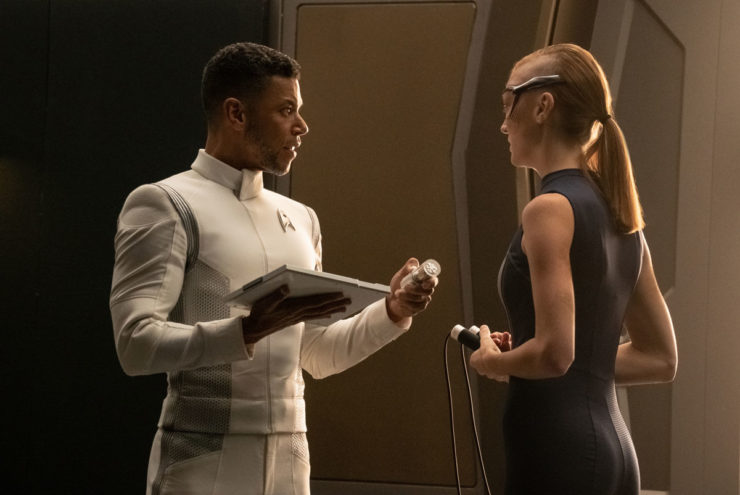
And she’s not the only one, though she’s the most extreme case because, as she herself eloquently puts it at the end of the episode, pilots are overburdened with machismo. The entire crew is a mess. Yes, they chose to travel nine centuries into the future, but that decision was made in the heat of a desperate battle with unbelievably huge stakes. Now that the battle is over and won, they now have to face the reality that they’re unimaginably far from their homes and loved ones.
Saru, to his credit, tries to deal with this. He asks Culber to medically examine the crew, and they’re all physically fit, but not so much psychologically. The captain brings the bridge crew to his quarters for dinner. It starts out well, with several of the crew trying their hand at haiku—which is a delightful scene. It’s Georgiou who starts it, and Culber’s screwup and Tilly’s counting out her syllables is particularly fun, though my favorite is Nhan’s utter confusion, as she has no idea what a haiku is.
Then it goes to shit when Detmer has an epic meltdown.
Not that she’s the only one, as her meltdown is primarily directed at Stamets. The Stamets who had mellowed from exposure to the spore drive, watching Culber die, and getting him back has been subsumed by the original-model, spectacularly obnoxious Stamets. To his credit, he eventually realizes it after Detmer tears him a new one, and he apologizes to Tilly for treating her like crap.
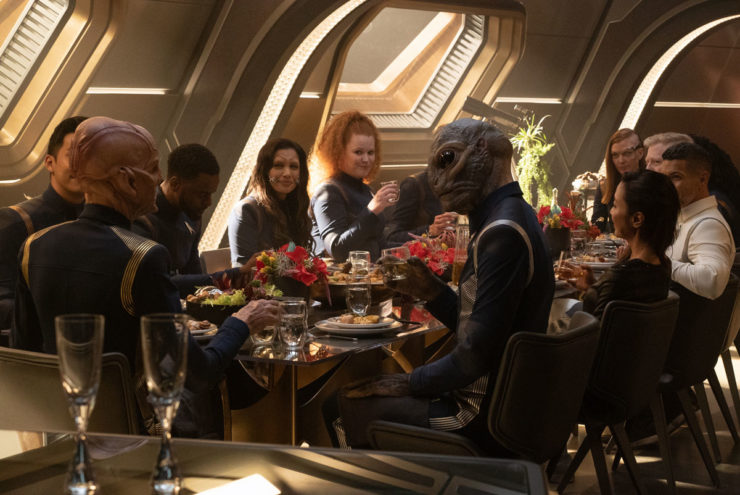
I love that Saru tried to get everyone to bond over a meal, and while it doesn’t go according to plan, it does have a positive effect eventually. Saru is still a scientist at heart, and he takes the same scientific-method approach to dealing with the crew’s issues that he took with his first time commanding Discovery back in “Choose Your Pain.” After Culber checks the crew and they have a good talk on the subject, he consults the computer.
The Sphere Data is apparently starting to impinge on the ship’s computer, and this could be a thing moving forward. Whether it’s a good thing or a bad thing will depend on how much Discovery wants to fall back on Trek‘s rather hoary tendency to vilify artificial intelligence. (Seen as recently as last season with Control, not to mention the AI ban in Picard.) For now, though, it’s a good thing, as it gives Saru the delightful idea of showing holographic re-creations of Buster Keaton films, which prove cathartic to a stressed crew.
Culber is beautifully used here, as he’s in a unique position, having died and come back. He’s already had everything he knows taken away from him in a much more devastating manner. It’s why he gives the advice to Saru he does, and also why he suggests that Burnham be the one to take Adira down to Trill.
Which brings us nicely to the actual A-plot and source of the title. Adira has a Trill symbiont inside her, but can’t access the symbiont’s memories beyond knowing that its name is Tal, and was once bonded with the Starfleet admiral who sent the message that led Discovery to Earth last week. Turns out that that’s not the only amnesia Adira is suffering from: she doesn’t remember anything that happened to her prior to a year ago..
So they go to Trill. “Forget Me Not” does an excellent job of re-creating the symbiont pools we saw on DS9’s “Equilibrium,” but where the 1994 episode looked like another reuse of a cave set the franchise had used a billion times already, Discovery makes the caves look much more like an alien landscape filled with wondrous beings.
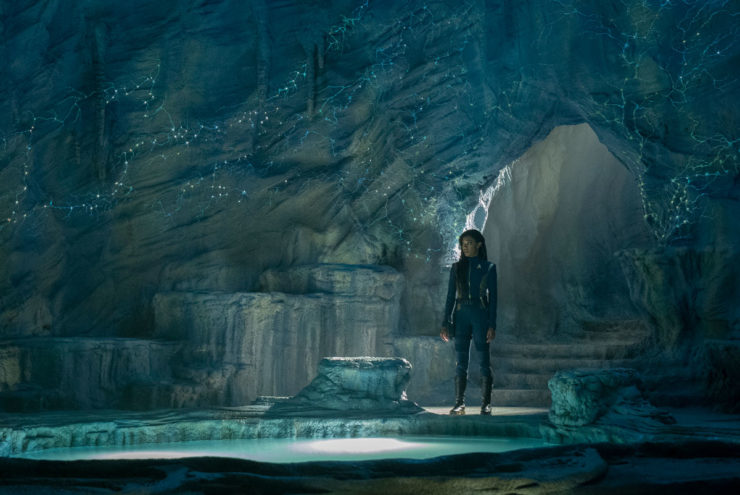
Trill has fallen on hard times, as the symbionts are scattered throughout the galaxy and the Burn makes it difficult for many of them to travel home. They are, at first, thrilled with the return of Tal, but Adira’s inability to remember anything, as well as her not being Trill, are major points against her. Apparently, no non-Trill has successfully hosted a symbiont before. (We saw an unsuccessful example in the Trill’s first appearance in TNG’s “The Host.”) Some of those present wish to extract the symbiont by force from her, and while the planetary leader keeps that from happening, at least at first, Adira and Burnham are kicked offworld.
However, one failed ambush later, Burnham and Adira are led to the symbiont caves so Adira can go into the symbiont pools and try to reconnect with Tal.
The journey Adira goes on—aided by Burnham who has to help her get past the fear—is fascinating. In a nice twist, Adira did not get the symbiont from the admiral, as was a natural assumption. Her lover, Gray, was a Trill who received the symbiont after the admiral died, but then Gray died in a horrible accident. Adira volunteered to host the symbiont to keep Tal from dying.
The Trill themselves come around to Adira hosting Tal, especially once she is able to name all her previous hosts. (I love that ritual, as the Trill muckitymucks ask Adira what her names are, wanting to make sure that the current host remembers all the prior ones.) This is predicated on the fact that not every Trill can host a symbiont, and there aren’t enough viable hosts on Trill post-Burn for all the symbionts. But if aliens can host them…
My only issue here is that “Equilibrium”—the very episode that gave us our first look at the Trill homeworld and the symbiont caves—established that fifty percent of Trills were biologically capable of hosting symbionts. Of course, a lot may have changed in the eight hundred years of story time that have elapsed since “Equilibrium” as well…
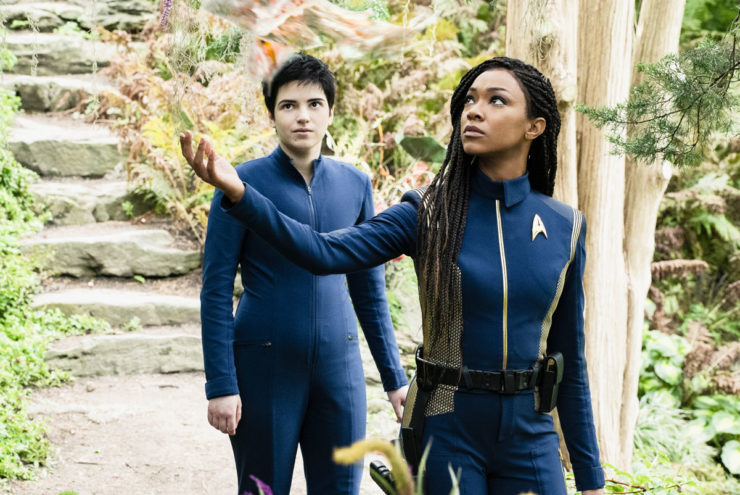
This is a superb episode, with some magnificent performances up and down the line. We start with Doug Jones’ earnestness in portraying Saru trying to help his crew and sadness that he’s not as successful as he’d like. (His lament that Captain Pike made it look so easy to lead the crew was particularly well delivered.) Mary Wiseman is delightfully knowing as awkward dinners were the norm in the Tilly household, while Anthony Rapp beautifully plays a Stamets who is retreating to old patterns in an attempt to reclaim normalcy in a situation that is as far from normal as possible. Sonequa Martin-Green does great work as Adira’s advocate, bodyguard, and mentor, keeping her on track to get her memories back.
But the standouts here are Emily Coutts as Detmer, Blu del Barrio as Adira, and especially Ian Alexander as Gray. Coutts makes Detmer’s pain and suffering real and visceral when she loses it at the captain’s dinner table, especially given how blank-faced and remote she’d been in the episode prior to that.
And del Barrio and Alexander give us a magnificent romance in an impressively short time, aided by a tight script by staffers Alan McElroy, Chris Silvestri, and Anthony Maranville and brilliant directing by Hanelle Culpepper. Alexander’s infectious joy and del Barrio’s loving confusion and worry combine to invest the viewer in their relationship, and it nails you right in the heart when Gray is mortally wounded.
Discovery has been doubling down on Star Trek’s historic commitment to trying to represent all of humanity. In the 1960s, that just meant actually including people in the crew who weren’t white males, which was the right way to start. In this episode, we not only have our first non-white Trill (seriously, all the Trill we ever saw on DS9, as well as TNG episodes and movies, were white), but also the non-binary del Barrio and the trans Alexander.
The person who now fully identifies as Adira Tal is offered the opportunity to stay on Trill, but instead chooses to stay on Discovery (because del Barrio has a contract to be in more than two episodes, obviously). And Adira is still seeing images of Gray even after leaving the symbiont pools, which is worrying. Trill have done this kind of thing before (cf. DS9‘s “Field of Fire“), but it required an extensive ritual. That it’s happening naturally is a bit odd, and while it’s great to see more of Alexander’s Gray, I hope this doesn’t cause more problems for Adira.
Keith R.A. DeCandido discussed last week’s Supernatural episode as part of the Dragon Con Urban Fantasy Track’s ongoing weekly look at the final episodes of that show, alongside Gail Z. Martin, Beth Dolgner, Damian Allen, Kristin Jackson, and moderator Carol Malcolm.










